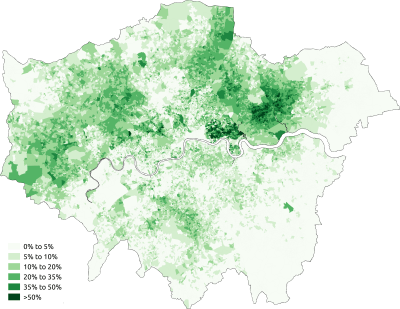Religion in London
London has centres of worship for a multitude of faiths. According to the 2011 Census, the largest religious groupings are Christians (48.4 per cent), followed by those of no religion (20.7 per cent), no response (8.5 per cent), Muslims (12.4 per cent), Hindus (5.0 per cent), Jews (1.8 per cent), Sikhs (1.5 per cent), Buddhists (1.0 per cent) and other (0.6 per cent).[1]
In 2001, the numbers were respectively Christians (58.2 per cent), followed by those of no religion (15.8 per cent), no response (8.7 per cent), Muslims (8.5 per cent), Hindus (4.1 per cent), Jews (2.1 per cent), Sikhs (1.5 per cent), Buddhists (0.8 per cent) and other (0.5 per cent).
Distribution
| Distribution of religions in Greater London according to the 2011 census. | ||||||||||||||||
|---|---|---|---|---|---|---|---|---|---|---|---|---|---|---|---|---|
|
Christianity in London
-

St Paul's Cathedral, the main Anglican church north of the Thames
-

Southwark Cathedral, its southern counterpart
-

Westminster Cathedral, the main Catholic church of London
Historically, London has been predominantly Christian. This is clear from the large number of churches around the area, particularly in the City of London, which alone contains around 50 churches. Anglicanism is the primary denomination, and the Archbishop of Canterbury's main residence is actually at Lambeth Palace. Most parts of London north of the Thames and west of the River Lee are within the diocese of London under the Bishop of London at the famous St Paul's Cathedral in the City, parishes east of the River Lee are within the Diocese of Chelmsford, whilst most parts south of the river are administered from Southwark Cathedral as the diocese of Southwark. Important national and royal ceremonies are divided between St Paul's and Westminster Abbey.
The pre-eminent Catholic cathedral in England and Wales is Westminster Cathedral, from where the Archbishop of Westminster leads the English and Welsh Catholic church. Other Christian denominations also have headquarters in the city, including the United Reformed Church, the Salvation Army and the Quakers, and immigrant communities have established their own denominations or dioceses (e.g. Greek Orthodoxy). Evangelical churches are also present in the city.
Islam in London
Islam is London's second largest religion. 38% of England's Muslims live in London, where they represent 12.4% of the population. There were 1,012,823 Muslims reported in the 2011 census in the Greater London area.[1]
London Central Mosque is a well-known landmark on the edge of Regent's Park, and there are many other mosques in the city. However, another landmark was set when Baitul Futuh Mosque was constructed in 2003 by the Ahmadiyya Muslim Community, being the largest mosque in Western Europe.
Hinduism in London

Over half of the UK's Hindu population live in London, where they make up 5% Every borough has a significant Hindu population and as per the 2011 census, the London borough of Harrow has the largest concentration of Hindus at 25%.
The Hindu temple at Neasden was the largest temple of Hinduism in Europe,[2] until the opening of the Shri Venkateswara (Balaji) Temple in Tividale in 2006.[3] Other temples are located in nearby Wembley, Harrow and Willesden, as well as Wimbledon and Newham in South and East London.
Hare Krishna are sometimes seen on the streets of London, particularly near the Radha Krishna Temple in Soho.
Judaism in London
Over two-thirds of British Jews live in London, which ranks thirteenth in the world as a Jewish population centre.[4] There are significant Jewish communities in parts of north London such as Stamford Hill and Golders Green.[5] There are currently two eruvin in London; one that covers Hendon, Golders Green, and Hampstead Garden Suburb,[6][7] and another in Edgware.[8] There are two more planned eruvin; one in Stanmore,[9] and one covering Elstree/Borehamwood.[10]
The first written record of Jewish settlement in London dates from 1070, although Jews may have lived there since Roman times. Bevis Marks Synagogue built in 1701 in the city of London is the oldest synagogue in the United Kingdom still in use. In 1899, a map was published showing by colour the proportion of the Jewish population to other residents of East London, street by street. It illustrates clearly the predominantly Jewish population at the time of the areas of Whitechapel, Spitalfields and Mile End in particular.[11]
Sikhism in London

London is home to a large Sikh population, who are mainly settled around the west of the city, in suburbs like Southall and Hayes.
The largest Sikh temple in London (and Europe[12]) is Gurdwara Sri Guru Singh Sabha in Southall.
See also
- Wembley’s Conference of Living Religions 1924
- List of churches in London
- Demography of London
- Religion in England
External links
- Reassessing what we collect website History of minority religions in London with objects and images
References
- 1 2 3 "2011 Census: KS209EW Religion, local authorities in England and Wales". ons.gov.uk. Retrieved 15 December 2012.
- ↑ Hindu London, BBC, 6 June 2005. URL accessed on 5 June 2006.
- ↑ Opening for biggest Hindu temple BBC, 23 August 2006. URL accessed on August 28, 2006.
- ↑ Metropolitan Areas With Largest Jewish Populations, 1 Jan 2002 www.jafi.org.il
- ↑ BBC London feature on Jewish communities, 11 Aug 2004 www.bbc.co.uk
- ↑ "NW London Eruv Website". North West London Eruv Committee. Retrieved 2007-10-17.
- ↑ "Eruvs in Britain". Religion & Ethics - Judaism. BBC. 2006-07-20. Retrieved 2007-10-17.
- ↑ "The Edgware Eruv Website". Edgware Eruv Committee. Retrieved 2007-10-17.
- ↑ "Welcome To The Stanmore Eruv". Retrieved 2010-08-02.
- ↑ "Elstree & Borehamwood Eruv homepage". Ebor Eruv Charitable Trust. Retrieved 2007-11-12.
- ↑ Jewish East London 1899
- ↑ "£17m Sikh temple opens". BBC News Online. 2003-03-30. Retrieved 2009-12-08.








